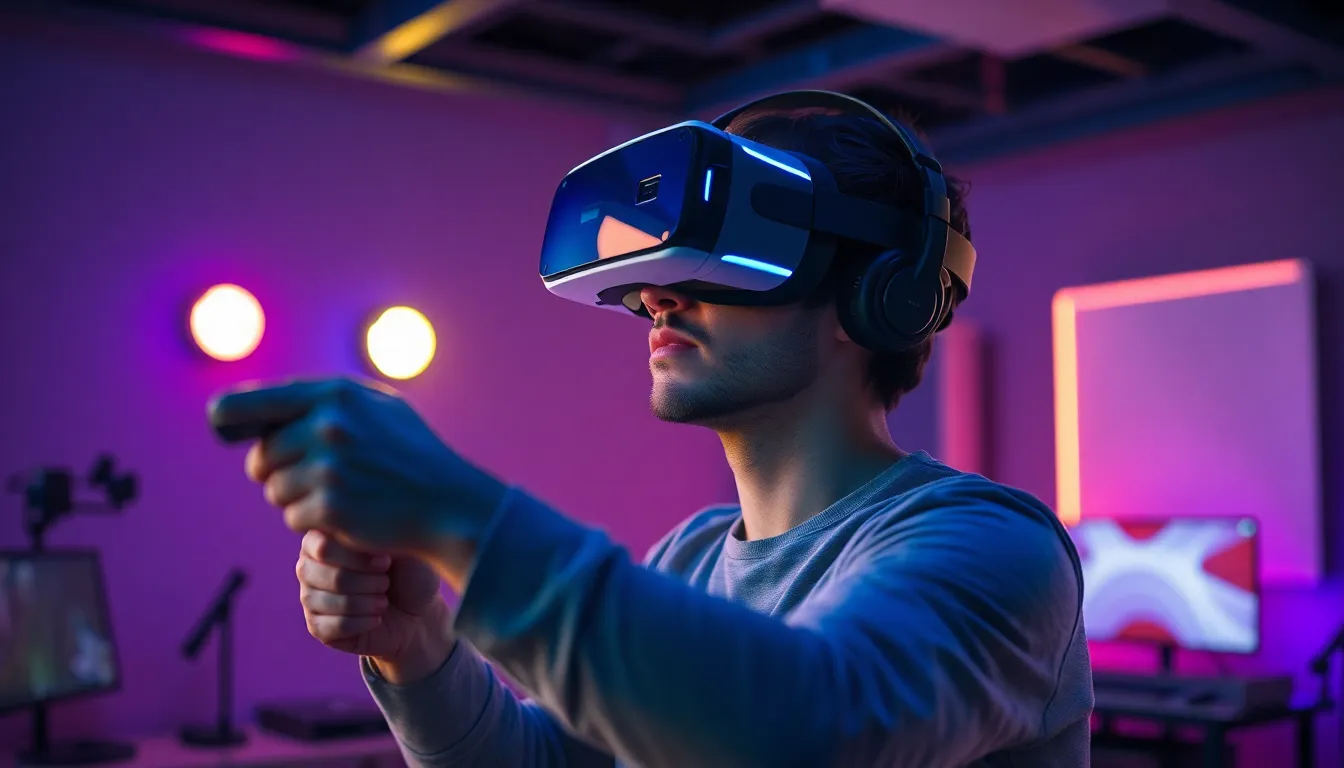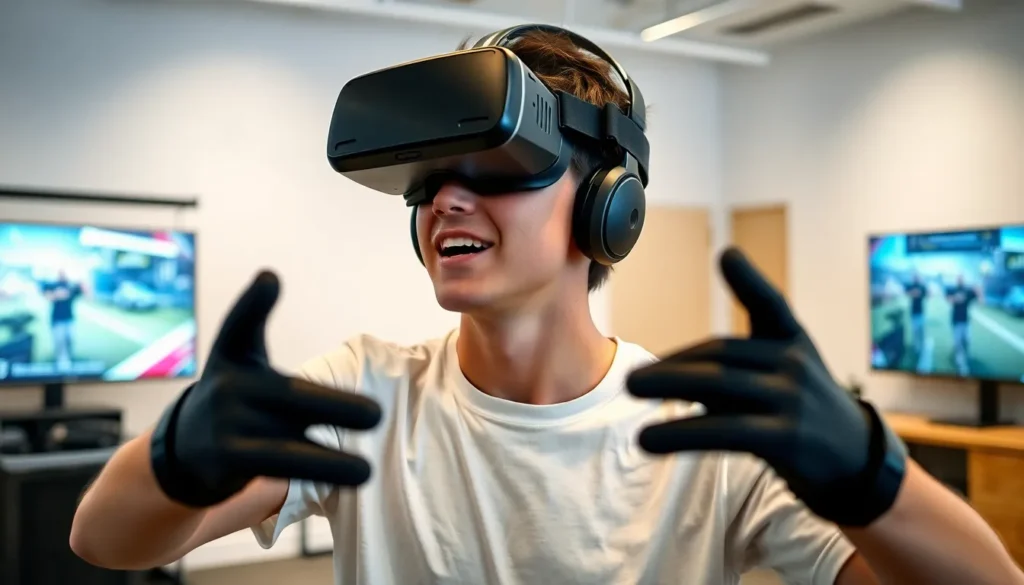Table of Contents
ToggleVirtual reality (VR) vision systems are revolutionizing the way people interact with digital environments. By creating immersive experiences, these systems enhance everything from gaming to training simulations, allowing users to engage with content in ways never before possible. As technology advances, the potential applications for VR vision systems continue to expand, making them a game-changer in various industries.
From healthcare to education, VR vision systems are not just about entertainment; they’re transforming how professionals train and learn. With the ability to simulate real-world scenarios, these systems offer a safe and effective way to develop skills and knowledge. As the demand for innovative solutions grows, understanding the intricacies and benefits of VR vision systems becomes crucial for businesses and individuals alike.
Overview of VR Vision Systems
VR vision systems integrate advanced technologies to deliver immersive virtual environments. These systems utilize headsets, sensors, and software to create realistic simulations. Users experience 3D visuals, spatial audio, and interactive elements that respond to movements and gestures.
Key Components
- Headsets
- Provide visual output through displays that create a 3D experience. Popular models include the Oculus Rift and HTC Vive.
- Sensors
- Track user movements and gestures. Devices like motion trackers and cameras enhance interaction within the virtual space.
- Software
- Powers the VR experience with applications tailored for gaming, training, and education. Platforms like Unity and Unreal Engine facilitate content creation.
Applications
Gaming
- VR vision systems enhance user engagement by providing fully immersive experiences. Titles like Beat Saber and Half-Life: Alyx exemplify this innovation.
Training Simulations
- Industries use VR for safe, practical training scenarios. Sectors such as healthcare and aviation benefit from real-world practice without risk.
Education
- VR fosters interactive learning experiences. Students can explore historical sites or conduct scientific experiments, enhancing retention and comprehension.
Benefits
Enhanced Engagement
- Users interact more deeply with content, increasing motivation and interest.
Safe Simulations
- Participants practice high-risk scenarios without real-world consequences, making learning safer and more effective.
- VR vision systems can reach individuals unable to attend traditional training or educational settings due to geographic or physical limitations.
Understanding VR vision systems and their applications signifies their growing importance across various fields, shaping the future of digital interaction.
Key Technologies Behind VR Vision Systems

VR vision systems rely on a blend of hardware and software innovations that contribute to their effectiveness and realism. These technologies work together to create captivating experiences across various applications.
Hardware Components
- Headsets: Quality VR headsets deliver 3D visuals and surround sound, immersing users in the virtual environment. Popular models include the Oculus Quest and HTC Vive, each with features such as high resolutions and wide field of view.
- Sensors: Tracking sensors enable motion detection, capturing body movements and translating them into the VR space. Various types of sensors include infrared cameras and gyroscopes, allowing for precise interaction.
- Controllers: Motion controllers enhance user interaction by providing tactile feedback. These devices include buttons and touch-sensitive surfaces that replicate real-world actions within the virtual environment.
- Computing Power: VR systems require robust processing units. High-performance CPUs and GPUs ensure smooth rendering of graphics and real-time user feedback, critical for immersive experiences.
- Input Devices: Additional input options like haptic gloves and treadmills elevate user engagement, allowing more natural interactions and spatial movements during virtual experiences.
Software Innovations
- Graphics Rendering: Advanced rendering techniques, such as ray tracing, create realistic lighting and shadows, enhancing immersion in VR environments. These innovations make virtual spaces visually compelling.
- Simulation Software: Dedicated applications for training games and educational programs power VR scenarios. This software simulates real-world situations, providing context-rich experiences that benefit learning and skills development.
- User Interface (UI): Intuitive UIs streamline user interactions, making navigation within virtual environments seamless. Well-designed interfaces contribute to a more engaging user experience.
- Artificial Intelligence (AI): AI algorithms enhance the behavior of virtual characters, making interactions more lifelike. These enhancements allow users to engage with NPCs (non-player characters) that respond realistically.
- Networking Technologies: Multiplayer experiences in VR depend on efficient network protocols that minimize latency and ensure smooth interactions between users. Technologies such as 5G support these requirements, expanding the scope for collaborative VR experiences.
Applications of VR Vision Systems
VR vision systems enhance various sectors by providing immersive experiences tailored to specific needs. The applications span gaming, education, training, and healthcare, showcasing the versatility of this technology.
Gaming and Entertainment
VR vision systems transform gaming and entertainment by creating highly interactive environments. Titles like Beat Saber and Half-Life: Alyx leverage VR to deliver engaging gameplay experiences. Users interact with virtual worlds using motion-tracking hardware, resulting in real-time feedback and enhanced immersion. According to the Entertainment Software Association, 77% of gamers appreciate VR’s ability to create new, unique experiences, marking VR’s significant role in the evolution of digital entertainment.
Education and Training
VR vision systems reshape education and training by providing realistic simulations in safe environments. These systems support various training modules, from virtual classrooms to complex technical simulations. Institutions utilize VR to simulate real-world challenges, allowing learners to practice skills without consequences. Research from PwC highlights that learners in VR environments grasp concepts four times faster than in traditional settings. This method improves retention and engagement, significantly enhancing educational outcomes.
Healthcare
VR vision systems significantly impact healthcare by offering innovative solutions in patient treatment and surgical training. Medical professionals utilize VR for procedure simulations, enhancing skills in a risk-free setting. For instance, VR solutions help surgeons practice techniques before real operations, minimizing errors. Additionally, VR is used in therapeutic contexts, such as pain management and PTSD treatment, demonstrating its broad application across the healthcare spectrum. A study published in the Journal of Medical Internet Research found that 30% of participants experienced reduced pain during invasive procedures when using VR.
Advantages of VR Vision Systems
VR vision systems offer numerous advantages across various sectors, enhancing user experiences and improving outcomes.
- Enhanced Engagement
VR immerses users in interactive environments, significantly increasing retention rates and emotional connections. Studies show participants engage more effectively compared to traditional methods.
- Safe Simulations
High-risk scenarios can be practiced in a controlled setting using VR. This eliminates real-world consequences while allowing individuals to develop and refine their skills.
- Accelerated Learning
Research indicates learners in VR settings grasp concepts four times faster. Immersive experiences promote better information retention and understanding.
- Accessibility
VR enables training and education for individuals unable to attend conventional settings. This inclusivity allows diverse groups to benefit from high-quality learning opportunities.
- Cost Efficiency
By reducing the need for physical materials and travel, VR can lower training costs over time. Organizations save resources while maintaining a high standard of training.
- Realistic Training Scenarios
VR provides lifelike scenarios, allowing users to encounter and navigate real-world challenges without associated risks. This prepares them for actual situations effectively.
- Therapeutic Applications
In healthcare, VR aids in pain management, exposure therapy, and rehabilitation. Studies indicate significant patient improvements, showcasing its value in treatment plans.
- Collaborative Learning
Networking technologies facilitate multiplayer experiences, allowing users to interact and learn from each other. Collaboration enhances problem-solving and teamwork skills.
These advantages make VR vision systems an essential tool across gaming, education, and healthcare, improving experiences and outcomes significantly.
Challenges and Limitations
VR vision systems face several challenges and limitations that impact their effectiveness and adoption.
Technical Limitations
- Resolution Quality: Headset displays may suffer from low pixel density, leading to a screen-door effect that distracts users.
- Latency Issues: Delays in rendering graphics can disrupt user experience, causing motion sickness and deterring engagement.
- Battery Life: Wireless headsets often encounter short battery life, limiting prolonged use and affecting immersion.
User Experience Challenges
- Motion Sickness: Many users experience nausea or discomfort during VR sessions due to mismatched sensory inputs and lack of movement in the real world.
- Hardware Accessibility: High costs associated with VR headsets and accessories limit access for potential users, particularly in education and lower-income settings.
Content Development Barriers
- Content Availability: While gaming and simulations thrive, educational and professional training content still lags, impacting the full utilization of VR in various fields.
- Skill Gap: Developers face challenges creating compelling VR experiences, leading to a scarcity of quality content that meets user expectations.
Social and Ethical Concerns
- Isolation Risks: Prolonged use of VR can lead to social disconnection, as users may prefer virtual interactions over real-life socialization.
- Data Privacy: VR systems often collect sensitive data, raising concerns about user privacy and data security, particularly in clinical and educational environments.
Adoption Resistance
- Resistance to Change: Traditionalists may resist integrating VR into established practices, limiting the technology’s growth within institutions and industries.
- Training Requirements: Users may require extensive training to navigate complex VR systems, which can deter potential adopters.
These challenges highlight the need for ongoing advancements in technology, user education, and content creation to fully unleash the potential of VR vision systems.
The evolution of VR vision systems is reshaping how individuals interact with digital content. Their applications span gaming, education, and healthcare, demonstrating their versatility and transformative potential. As technology continues to advance, the immersive experiences offered by VR will only become more sophisticated.
While challenges such as technical limitations and accessibility remain, ongoing innovations are paving the way for broader adoption. The benefits of VR are undeniable, enhancing engagement and providing safe learning environments. As industries recognize the value of VR vision systems, the future promises even greater integration into everyday life. Embracing these advancements will unlock new possibilities and redefine user experiences across various fields.







